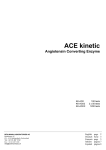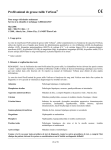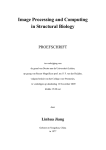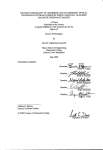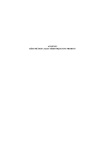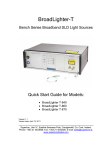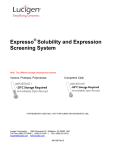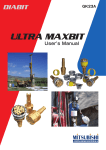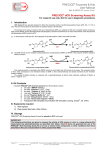Download ACE - Pishro Tashkhis Co Ltd
Transcript
Hitachi® ACE Liquid Reagent KIT SPECIFICATIONS: Cat. No. AUD309 Quantity 4 x 20 ml Reagent ACE Storage 2-8°C INTENDED USE: In Vitro Diagnostic reagent pack for the quantitative determination of Angiotensin Converting Enzyme (ACE) in serum and plasma on Hitachi® automated analysers. ACE is a peptidyl-dipeptidase that catalyses the conversion of active angiotensin I to the biologically active angiotensin II. ACE is an important enzyme in the Renin – Angiotensin – Aldosterone cycle. A number of ACE inhibitors are used in the control of hypertension. ACE is most frequently measured in patients with suspected Sarcoidosis in which, levels of three times the upper normal limit can be found. Successful subsequent treatment of this condition correlates well to declining ACE levels. Elevated ACE levels are also encountered in a number of other conditions including histoplasmosis, alcoholic cirrhosis, idiopathic pulmonary fibrosis, Hodgkin’s disease and hyperthyroidism. PRINCIPLE OF THE TEST: 1 Furylacryloylphenylalanylglycylglycine (FAPGG) is hydrolysed to Furylacryloylphenylalanine (FAP) and Glycylglycine (GG) as per equation. Hydrolysis of FAPGG results in a decrease in absorbance at 340 nm. The rate of decrease in absorbance is directly proportional to ACE activity in the sample. ⎯ACE ⎯→ ⎯ PERFORMANCE CHARACTERISTICS: Reagent 1 is ready for use. Before use, mix reagent by gently inverting each bottle. If stored and handled properly, unopened component is stable until expiry date stated on the label. Stability On Board the Instrument: 28 days. Performance results can vary with the instrument used. Data obtained in each individual laboratory may differ from these values. TYPE OF SPECIMEN: 2 Serum, free of haemolysis and lipemia, is the preferred specimen. Heparinised plasma can also be used. It is recommended to follow NCCLS procedures (or similar standardised conditions) regarding specimen handling. Specimen should be collected in an appropriate sample container, with proper specimen identification. Serum/plasma should be separated from cells within 2 hours after collection. Stability 2: up to 4 weeks at 4°C. TEST PROCEDURE: SUMMARY AND EXPLANATION: 2 FAPGG REAGENT PREPARATION AND STABILITY: FAP + GG WARNINGS AND PRECAUTIONS: For In Vitro Diagnostics Use Only - For Professional Use Only Carefully read instructions for use. Deviations from this procedure may alter performance of the assay. Components Colour and Appearance: Reagent 1: Colourless clear liquid. Any significant changes could indicate that the assay might be compromised. Refer to Laboratory’s QC program for actions to be taken. In case of serious damage to the bottle and/or cap, resulting in product leakage and/or contamination, do not use the reagent pack and contact your distributor. Safety precautions: This product is not hazardous under EU specifications. Material Safety Data Sheet is available upon request. Handling precautions: Take the necessary precautions required for handling all laboratory reagents. Do not use components past the expiry date stated on the Bottles. Do not Freeze Reagents. Do not use components for any purpose other than described in the “Intended Use” section. Do not interchange caps among components as contamination may occur and compromise test results. Refer to local legal requirements for safe waste disposal. Catalog. No. AD968 AQC306 AQC316 Interfering substances: Results of study are as follows: Bilirubin (mixed isomers): Haemolysis: Lipemia: Description Hitachi® Analyser Hitachi® Consumables General Laboratory Equipment Catalog. No. N/A N/A N/A Assay procedure: Refer to relevant user’s manual for instructions on instrument start-up, loading components and samples, calibration, sample testing procedures, calculating and reporting results. Calibration: Using recommended Calibrator, calibrate the assay: When using a new reagent kit or changing lot number. Following preventive maintenance or replacement of a critical part. When Quality Controls are out of range. Precision: Within Run N = 20 Level 1 Level 2 This assay is designed to run on Hitachi clinical chemistry analysers. Refer to relevant user’s manual or Laboratory internal practice for routine maintenance procedures. See enclosed application sheet. SD % CV 28.5 45.9 0.96 1.51 3.37 3.28 Between Run N = 20 Level 1 Level 2 Mean (U/l) SD % CV 29.4 45.2 1.49 2.85 5.05 6.30 Method Comparison: Using 50 samples, a comparison, between this ACE test (y) and another commercially available test (x), gave the following results: r = 0.980 Sample range: 1 to 81 U/l BIBLIOGRAPHY: 1. Price CP. Maguire GA. Ann. Clinical Biochemistry. 1985; 22.204-210. 2. Burtis CA., Ashwood ER.Tietz Fund. Of Clin. Chem. 5th ed.; 30-54 and 385. SYMBOLS: The following symbols are used in the labelling of Audit Diagnostics systems: IVD LOT CALCULATION: The analyser automatically calculates the ACE activity in the sample. (Conversion factor: Qty in μKat/l = Qty in U/l x 0.0167). In Vitro Diagnostics REF CONT Batch Code Catalogue No Content REAG Reagent Ab Antibody CAL Calibrator SUBS Substrate BUF EXPECTED VALUES: Buffer U/l 8 – 65 μkat/l 0.13 – 1.08 CE Mark - Device comply with the Directives 98/79/EC Storage temperature It is strongly recommended that each laboratory establish its own reference range. ACE results should always be reviewed with the patient’s medical examination and history. INSTRUMENTS: ® Mean (U/l) y = 1.020x + 5.148 Quality Control: All clinical laboratories should establish an Internal Quality Control program. Verify instrument and reagent performance with recommended controls or similar. The values obtained for QC should fall within manufacturer’s acceptable ranges or should be established according to the Laboratory’s QC program. Controls should be assayed: Prior reporting patient results. Following any maintenance procedure. At intervals established by the laboratory QC Programme. Over 14 years of age Less than 10% interference up to 600 µmol/l Bilirubin Less than 10% interference up to 1.25 g/l Haemoglobin Less than 10% interference up to 1.25 g/l Intralipid Sensitivity: The Lowest Detectable Level was estimated at 5.4 U/l (0.09 μkat/l). Materials required but not supplied: Description ACE Calibrator ACE Control Level 1 ACE Control Level 2 Linearity: This assay is linear up to 164 U/l (2.74 μkat/l). For samples with higher activity: Re-assay using, when available, “Rerun” function. Refer relevant user’s manual for instructions. Or, dilute 1:1 with 0.9% NaCl (9g/l) and re-assay. Multiply result by 2. anufactured By: → Reconstitute with Expiry Date (Last day of the month) Manufactured By Biological risk Consult Instruction for Use AUDIT DIAGNOSTICS, Business & Technology Park, Carrigtwohill, Co. Cork (Ireland) Tel: 00353 - (0) 21 – 4533 652 Fax: 00353 - (0) 21 – 4533 653 E-mail: [email protected] Website: www.auditdiagnostics.ie COMPONENT COMPOSITION: Page 1 of 2 Component Ingredients Concentration in Tests Reagent Borate Buffer pH 8.3 80 mmol/l FAPGG 0.75 mmol/l ® HITACHI 704/717/911/912/917/MODP ARE REGISTERED TRADEMARKS OF NISSEI SANGYO CO. LTD., JAPAN. Revision No. 05. Issued on 04 December 2006 ACE Hitachi® Instruments Settings Catalogue No(s): AUD309 HITACHI 704®: (Temperature: 37°C) CHEMISTRY PARAMETERS TEST CODE ASSAY CODE SAMPLE VOLUME R1 VOLUME R2 VOLUME WAVELENGTH CALIB. METHOD STD (1) CONC. POS. STD (2) CONC. POS. STD (3) CONC. POS. STD (4) CONC. POS. STD (5) CONC. POS. STD (6) CONC. POS. UNITS SD LIMIT DUPLICATE LIMIT SENSITIVITY LIMIT ABS LIMIT (INC/DEC) PROZONE LIMIT EXPECTED VALUE INSTRUMENT FACTOR HITACHI 911®: (Temperature: 37°C) [ACE] [2(2point)] - [14] - [32] [20] [330] - [__] - [NO] [0] - [__] - [NO] [700] - [340] [LINEAR] [__] - [__] [__] - [__] [0] - [0] [0] - [0] [0] - [0] [0] - [0] [__] [0.1] [220] [0] [0] - [DECREASE] [0] - [LOWER] [__] - [__] [1.00] [__] User Defined. HITACHI 717®: (Temperature: 37°C) CHEMISTRY PARAMETERS TEST CODE ASSAY CODE SAMPLE VOLUME R1 VOLUME R2 VOLUME WAVELENGTH CALIB. METHOD STD (1) CONC. POS. STD (2) CONC. POS. STD (3) CONC. POS. STD (4) CONC. POS. STD (5) CONC. POS. STD (6) CONC. POS. SD LIMIT DUPLICATE LIMIT SENSITIVITY LIMIT ABS LIMIT (INC/DEC) PROZONE LIMIT EXPECTED VALUE PANIC VALUES INSTRUMENT FACTOR [__] User Defined. Page 2 of 2 [ACE] CHEMISTRY PARAMETERS TEST CODE ASSAY CODE WAVELENGTH (SUB-MAIN) ASSAY POINT DILUTION SAMPLE VOLUME (μL) ABS LIMIT PROZONE LIMIT R1 REAGENT (μL) R2 R3 R4 CALIBRATION TYPE SD LIMIT DUPLICATE LIMIT SENSITIVITY LIMIT SI ABS. LIMIT UNIT INSTRUMENT A FACTOR (Y=AX+B) B STD 1 STD 2 STD 3 STD 4 STD 5 STD 6 HITACHI 902®: (Temperature: 37°C) [ACE/G] [2 Point End] - [10] [700] - [340] [14] - [31] [__] - [__] [25] - [__] [32000] - [DECREASE] [32000] - [UPPER] [250] - [0] - [0] [0] - [0] - [0] [0] - [0] - [0] [0] - [0] - [0] [LINEAR] - [2] - [2] [999] [32000] [__] [-32000] - [32000] [__] - [__] [1.00] [0] - [0] [__] - [__] [__] - [__] [__] - [__] [__] - [__] [__] - [__] [__] - [__] [__] User Defined. [2(2point )] - [22] - [50] [25] - [2] [250] - [__] - [NO] [0] - [__] - [NO] [700] - [340] [LINEAR] [__] - [__] [__] - [__] [0] - [0] [0] - [0] [0] - [0] [0] - [0] [0.1] [220] [0] [0] - [DECREASE] [0] - [LOWER] [__] - [__] [__] - [__] [1.00] HITACHI 917/MODULAR P®: (Temperature: 37°C) CHEMISTRY PARAMETERS TEST NO TEST NAME TEST CODE MODULE P ASSAY CODE MEASUREMENT POINTS WAVELENGTH (SUB-MAIN) SAMPLE VOLUME (μL) S VOLUME (DECREASE/INCREASE) R1 REAGENT (μL) R2 R3 R4 ABS LIMIT PROZONE LIMIT TECHNICAL LIMIT (LOW/HIGH) REPEAT LIMIT (LOW/HIGH) CALIBRATION SD LIMIT DUPLICATE LIMIT SENSITIVITY LIMIT (LOW/HIGH) S1 ABS. LIMIT (LOW/HIGH) STD 1 STD 2 STD 3 STD 4 STD 5 STD 6 [__] [ACE] [__] [__] [2POINT END] - [10] - [__] [17] - [30] - [0] - [0] [700] - [340] [25] [__] - [__] [250] - [__] - [__] [0] - [__] - [__] [0] - [__] - [__] [0] - [__] - [__] [32000] - [INCREASE] [-32000] - [LOWER] [__] - [__] [__] - [__] [LINEAR] - [2] - [2] [999] [32000] [__] - [__] [-32000] - [32000] [__] - [__] [__] - [__] [0] - [0] [0] - [0] [0] - [0] [0] - [0] CHEMISTRY PARAMETERS TEST NAME ASSAY CODE ASSAY POINTS WAVELENGTH (SUB-MAIN) SAMPLE VOLUME (μL) REAGENT (VOL-POS-BOTTLE SIZE) CALIBRATION CALIB 1 (CONC/POS) CALIB 2 (CONC/POS) CALIB 3 (CONC/POS) CALIB 4 (CONC/POS) CALIB 5 (CONC/POS) CALIB 6 (CONC/POS) S1 ABS K FACTOR K 2 FACTOR K 3 FACTOR K 4 FACTOR K 5 FACTOR A FACTOR B FACTOR C FACTOR SD LIMIT DUPLICATE LIMIT SENSITIVITY LIMIT S1 ABS. LIMIT (LOW/HIGH) ABS LIMIT PROZONE LIMIT PROZONE (END POINT) EXPECTED VALUES INST FACTOR (A - B) KEY SETTING R1 R2 R3 [ACE] [2 POINT END] - [10] - [__] [17] - [30] - [0] - [0] [700] - [340] [25] [250] - [__] - [__] [0] - [__] - [__] [0] - [__] - [__] [LINEAR] - [2] - [2] [__] - [__] [__] - [__] [0] - [0] [0] - [0] [0] - [0] [0] - [0] [0] [10000] [10000] [10000] [10000] [10000] [0] [0] [0] [0.1] [500] [0] [-32000] - [32000] [9000] - [DECREASE] [0] - [MIN] [35] [__] - [__] [1] - [0] ….. [__] User Defined. Revision No. 05. Issued on 04 December 2006


